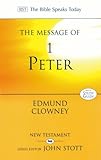A 186 page commentary / exposition of the book of Zechariah. It is part of the Bible Speaks Today series which generally follows an expositional format – not just explaining the Scriptures but applying it. The subtitle is “Your Kingdom Come” and the whole exposition of the book takes a kingdom perspective.
The Introduction
The introduction is a fairly generous 30 pages, and Webb shows that the structure of the book is eight visions followed by two oracles. He sums up the main theme by saying “it is a book about the future coming of the kingdom of God, and the need to live now in the light of it”. He also points out sub-themes of repentance and cleansing as well as an key theme of the Messiah running through the book. He puts Zechariah’s prophecy into its historical context, but also is very careful to show how his message is directly applicable to us, as we have the same concern to see God’s kingdom come. He highlights how regularly the NT writers draw from the book of Zechariah.
The Commentary
The commentary itself is able to devote a couple of pages to each small section of Zechariah which gives enough space to explain and apply the text adequately. Webb generally avoids detailed discussions of historical context or Hebrew grammar, and is cautious in offering his interpretations of some of the more obscure visions.
He shows how there is a progression in the visions of the first six chapters that culminate in God’s judgment and rule over all the earth. He acknowledges that chapter 7 marks a new beginning, but argues that it is not unrelated to what had gone before. In chapters 10 and 11, he draws out a major theme of leadership – true shepherds are those who trust in God and lead others to do the same.
… it is impossible to be in relationship with God unless we are prepared to be ruled by him.
When he comes to chapter 13, he explains the links to Jesus, and there is also a brief excursus that deals in more detail with the use of Zechariah in the New Testament. He argues that the Old Testament prophecies concerning the kingdom of God are fulfilled in the events of Jesus’ life – his birth, ministry, death, resurrection, ascension and return. Hence there are elements of kingdom prophecy in Zechariah yet to be fulfilled.
Strengths
For me, the great strength of this volume is how he consistently draws us to the Christological and New Covenant implications and interpretation of the book. He takes what can be a perplexing book, and brings out a very challenging and practical message of the kingdom of God.
Weaknesses
Nothing to complain of. It was the right length. It obviously isn’t an academic treatment of Zechariah, and also those looking for detailed and speculative explanations of every last detail of the visions will be disappointed. But it ranks as one of my favourites in the BST series.
Why Buy It?
As with pretty much all the BST volumes, this is ideal if you are personally studying or planning to preach or teach on the book of Zechariah.










